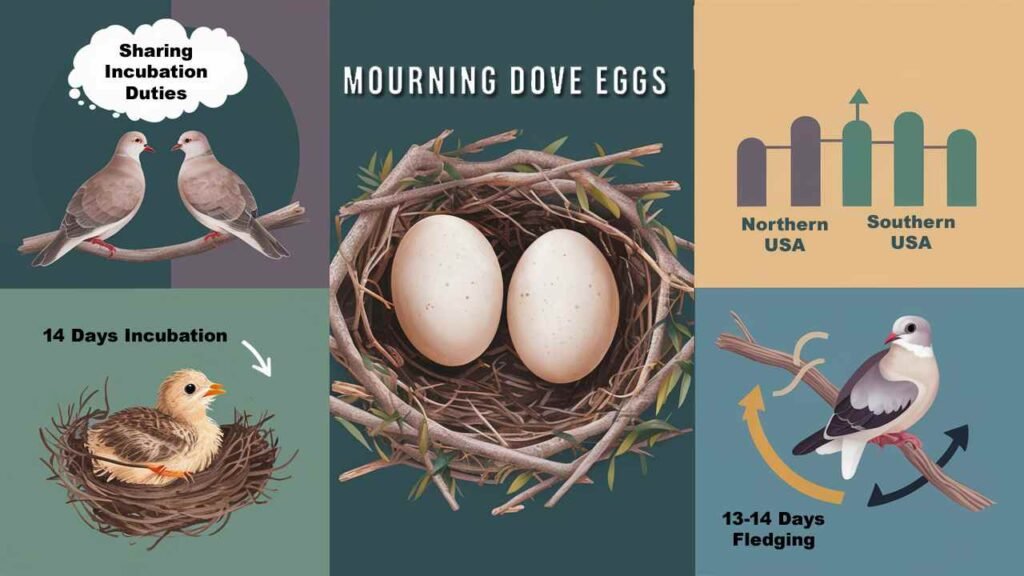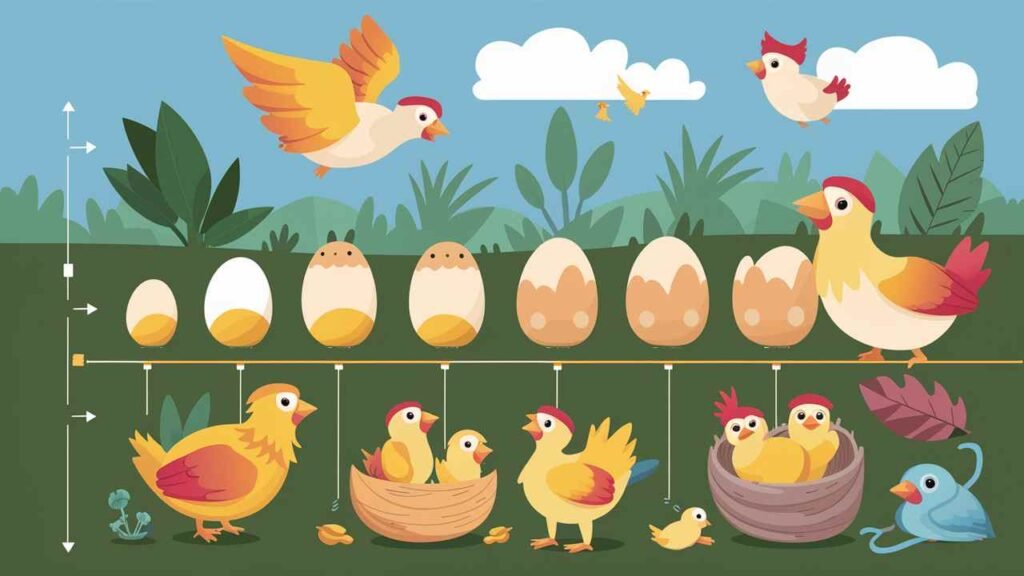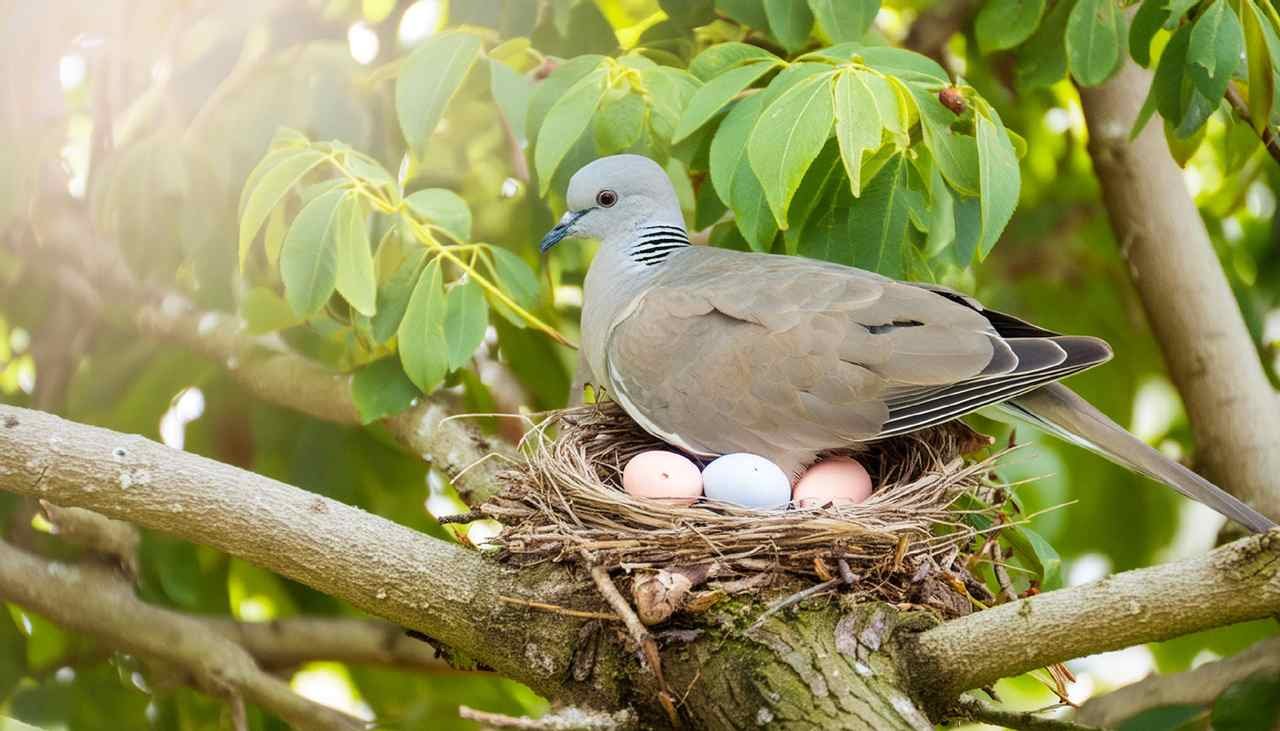Ever noticed a mourning dove on a slim branch, nursing a tender nest? In these nests, we find an amazing thing: mourning dove eggs. Small and modest, these eggs mark the beginning of an incredible transformation. They start as tiny life points and become beautiful birds that decorate our skies. Learning the life cycle of mourning dove eggs isn’t just interesting for bird watchers, it’s also important for saving these species.
The Mourning Dove Egg Cycle: A Step-by-Step Breakdown
Mourning doves (Zenaida macroura) have a reputation for their sad cooing sounds. They breed a lot in North America. When is their breeding season? Mostly, it’s during spring and summer. Why then? Because of the warm weather and lots of food. But, it’s not always the same time. It changes a bit, depending on where they live. Like, mourning doves living down south might start breeding before those up north. What else could change the start of this season? Well, stuff like the weather and how much food there is.
Once breeding commences, the female mourning dove lays a clutch of eggs. Here’s a closer look at each stage of the mourning dove egg cycle:

When Do Mourning Doves Lay Eggs?
Mourning doves have a strong focus on bringing up their young ones. They have the ability to rear up to six groups of young birds every year, with two eggs in each group. This incredible rate of breeding helps keep their numbers steady. It’s interesting to note, when their first group of eggs face challenges like predators or tough weather, the mourning dove pair might lay new eggs. This gives their yet-to-be-born birds another opportunity to flourish.
| Region | Typical Breeding Season |
|---|---|
| Southern North America | March – September |
| Northern North America | April – August |

How Many Eggs Do Mourning Doves Lay?
Mourning doves usually lay two eggs at a time. They’ll lay them one or two days part. This makes sure the babies hatch all at once. It’s like a smart plan from nature. It helps mom and dad birds do their job easier. Cool fact – if something goes wrong with the first try, like a predator, the doves can have another go. They might lay eggs again. It shows how much they want to be parents. It also helps them have enough babies.
Mourning Dove Egg Appearance: A Close Look
Mourning dove eggs are marvels of simplicity and efficiency. Let’s delve into their physical characteristics:
- What Color Are Mourning Dove Eggs? – The eggs are stunning, untouched white. Such a shade is perfect for hiding in the nest. It effortlessly blends with twigs and leaves.
- How Big Are Mourning Dove Eggs? – They’re quite tiny, to your surprise, they measure around 1 inch (2.5 centimeters) in length and 0.8 inches (2.1 centimeters) across. This tininess lets two eggs cozy up in the snug Mourning Dove nest.
Mourning Dove Egg Size
| Measurement | Size |
|---|---|
| Length | 1 inch (2.5 centimeters) |
| Width | 0.8 inches (2.1 centimeters) |
- What Do Mourning Dove Eggs Look Like? – White mourning dove eggs are smooth and oval, with no marks or designs. These plain characteristics help to hide the nest from danger and safeguard the baby birds from harmful creatures.
The Incubation Process: Inside the Mourning Dove Nest
Once the clutch is complete, the incubation period begins. This is a crucial stage where the developing embryos rely on the warmth provided by their parents to grow.

- How Long Do Mourning Doves Sit on Their Eggs? – It’s a team effort when it comes to mourning doves and their eggs. Male and female both take a shift, keeping the eggs warm for about two weeks. It keeps the eggs perfectly warm which helps the little birds grow inside.
Mourning Dove Egg Development Timeline
| Stage | Duration (Days) | Description |
|---|---|---|
| Egg Laying | 1-2 days | Female lays two eggs at an interval of 1-2 days. |
| Incubation | 14 | Both parents share incubation duties, keeping eggs warm for optimal embryo development. |
| Hatching | 1 | Chicks emerge from their shells, starting their journey to fledging. |
| Eyes Open | 2-3 | Chicks’ eyes open, allowing them to see their surroundings. |
| Feather Growth | 7-10 | Chicks develop down feathers, followed by flight feathers. |
| Thermoregulation | 10 | Chicks gain some ability to regulate their body temperature. |
| Leaving the Nest | 13-14 | Chicks take their first steps out of the nest, attempting short flights. |
| Fledgling Care | 21-28 | Parents continue feeding and caring for chicks until they become independent. |
- Do Male Mourning Doves Sit on Eggs? – In contrast to certain avian creatures where only the females incubate, male mourning doves take an active role in warming their eggs. This partnered parenthood is vital for raising a successful flock of mourning doves.
- Do Mourning Doves Leave Their Eggs Unattended? – Mourning dove parents are very attentive to their eggs. However, they do sneak away from the nest sometimes, but just to find food. They aren’t gone long – just a few minutes – to keep egg-eaters away.
Hatching and Beyond: The Journey from Egg to Fledgling
After a period of dedicated incubation, the magic of hatching unfolds:
- When Do Mourning Dove Eggs Hatch? – Following an incubation period of around 14 days, the mourning dove eggs hatch, revealing tiny, helpless chicks.
| Stage | Duration |
|---|---|
| Hatching | Approximately 14 days after incubation beginspen_spark |
- Can Mourning Doves Move Their Eggs? – Mourning doves differ from certain bird species. They can’t move their eggs around in the nest too much. Why? Well, their parent instincts make them warm up eggs just as they’re laid. Also, the nest shape doesn’t let them move around much.
Mourning Dove Nest Composition
| Material | Purpose |
|---|---|
| Twigs and Sticks | Provides the main framework for the nest. |
| Leaves and Grasses | Adds insulation and helps camouflage the nest. |
| Bark Flakes | May be used for additional insulation and structural support. |
| Feathers | Sometimes incorporated for added warmth and comfort for the chicks. |
Here’s what unfolds after the eggs hatch:
- The Chick’s First Days – Newly hatched mourning dove babies are helplessly reliant on their mommy and daddy birds, unable to fend for themselves. Unable to see and bare-skinned, their bodies are just covered in soft, fuzzy fluff to keep warm. The bird parents switch off, giving their chicks food that’s been chewed up and spit back out, packed with seeds and bugs.
Mourning Dove Parental Care Duties
| Parent | Duties |
|---|---|
| Male | Shares incubation duties, keeps watch over the nest, and regurgitates food for chicks. |
| Female | Lays eggs, shares incubation duties, and regurgitates food for chicks.pen_spark |
- Growing Fast – Within the next fortnight, the offspring transform quickly. Their vision begins in just a few days, and fluff starts to show. By the tenth day, they start managing their body temperature to a degree. This lets mom and dad do some extra food hunting away from home.
- Moving Out – When they reach about two weeks old, it’s time for these baby doves to take their first shaky steps outside their home. They aren’t quite ready for full flight, but they can bounce short spans and clamber on nearby branches. Even as these toddlers start exploring, their parents still nurture and provide for them for the next month until they can stand on their own two feet.
Threats to Mourning Dove Eggs and Chicks
The mourning dove egg and chick stages are vulnerable times in the breeding cycle. Here are some of the common threats they face:
- Threat – Birds of prey such as hawks, and small mammals like squirrels and raccoons, often target doves’ nests. These predators find eggs and little chicks easy to catch because they’re small and don’t move much.
- Habitat Loss – City building and forest chopping make it hard for mourning doves to find places to nest. This loss of places to live can really change how well they breed.
- Tough Weather – Bad weather like lots of rain, heavy winds, or sudden cold can hurt nests. This exposes eggs and chicks to bad weather, making survival tricky.
Conservation Efforts for Mourning Doves
Mourning doves are a valuable part of the North American ecosystem, and their populations are facing challenges. Here’s how we can help:
- Provide Nesting Sites – Got some space in your yard or garden? You can help mourning doves out by building nesting boxes for them. It’s a good, safe place for them to bring up babies. Keep wild spaces too, if you can.
- Maintain Natural Habitats – Trees and bushes are perfect for doves to set up homes and they find food there too.
- Minimize Pesticide Use – Doves snack on bugs, so we need to be nice to the insects. Going natural on pest control is a big thumbs up for doves, helps keep their food supply healthy.
By understanding the mourning dove egg cycle and the threats they face, we can take steps to conserve these fascinating birds and ensure their continued presence in our skies.
Interesting Facts About Mourning Doves
| Fact | Description |
|---|---|
| Number of Broods per Year | Up to 6 broods in southern regions, fewer in northern areas. |
| Replacement Clutch | If the first clutch fails, mourning doves may lay a replacement clutch. |
| Shared Incubation Duties | Both male and female mourning doves participate in incubating the eggs. |
| Short Nest Attendance Gaps | Parents leave the nest for brief periods to forage for food. |
| Altricial Chicks | Mourning dove chicks are completely dependent on their parents for survival after hatching. |
| Fledgling Dependence | Fledglings remain dependent on parents for food for several weeks after leaving the nest. |
Conclusion
Mourning doves show strength by how they deal with habitat loss and predators. We see this in their egg cycle. At first, there are fragile eggs in a knitted nest. Then, young birds start to fly. Each part of this cycle reminds us how hard mourning doves work to stay alive. When we learn about their cycle, we understand why it’s important to save where they live. Things like offering nest boxes or protecting nature helps. This boosts the defense of these calm birds and the places they live. In the end, the egg cycle of mourning doves highlights our bond with nature. It prompts us to remember our duty to keep it safe for the ones coming after us.

